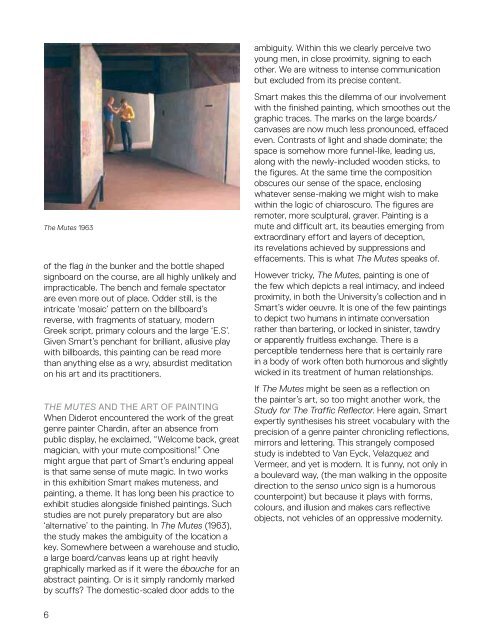Jeffrey Smart: Unspoken - The University of Sydney
Jeffrey Smart: Unspoken - The University of Sydney
Jeffrey Smart: Unspoken - The University of Sydney
You also want an ePaper? Increase the reach of your titles
YUMPU automatically turns print PDFs into web optimized ePapers that Google loves.
<strong>The</strong> Mutes 1963<br />
<strong>of</strong> the flag in the bunker and the bottle shaped<br />
signboard on the course, are all highly unlikely and<br />
impracticable. <strong>The</strong> bench and female spectator<br />
are even more out <strong>of</strong> place. Odder still, is the<br />
intricate ‘mosaic’ pattern on the billboard’s<br />
reverse, with fragments <strong>of</strong> statuary, modern<br />
Greek script, primary colours and the large ‘E.S’.<br />
Given <strong>Smart</strong>’s penchant for brilliant, allusive play<br />
with billboards, this painting can be read more<br />
than anything else as a wry, absurdist meditation<br />
on his art and its practitioners.<br />
the Mutes ANd the Art <strong>of</strong> pAiNtiNg<br />
When Diderot encountered the work <strong>of</strong> the great<br />
genre painter Chardin, after an absence from<br />
public display, he exclaimed, “Welcome back, great<br />
magician, with your mute compositions!” One<br />
might argue that part <strong>of</strong> <strong>Smart</strong>’s enduring appeal<br />
is that same sense <strong>of</strong> mute magic. In two works<br />
in this exhibition <strong>Smart</strong> makes muteness, and<br />
painting, a theme. It has long been his practice to<br />
exhibit studies alongside finished paintings. Such<br />
studies are not purely preparatory but are also<br />
‘alternative’ to the painting. In <strong>The</strong> Mutes (1963),<br />
the study makes the ambiguity <strong>of</strong> the location a<br />
key. Somewhere between a warehouse and studio,<br />
a large board/canvas leans up at right heavily<br />
graphically marked as if it were the ébauche for an<br />
abstract painting. Or is it simply randomly marked<br />
by scuffs? <strong>The</strong> domestic-scaled door adds to the<br />
6<br />
ambiguity. Within this we clearly perceive two<br />
young men, in close proximity, signing to each<br />
other. We are witness to intense communication<br />
but excluded from its precise content.<br />
<strong>Smart</strong> makes this the dilemma <strong>of</strong> our involvement<br />
with the finished painting, which smoothes out the<br />
graphic traces. <strong>The</strong> marks on the large boards/<br />
canvases are now much less pronounced, effaced<br />
even. Contrasts <strong>of</strong> light and shade dominate; the<br />
space is somehow more funnel-like, leading us,<br />
along with the newly-included wooden sticks, to<br />
the figures. At the same time the composition<br />
obscures our sense <strong>of</strong> the space, enclosing<br />
whatever sense-making we might wish to make<br />
within the logic <strong>of</strong> chiaroscuro. <strong>The</strong> figures are<br />
remoter, more sculptural, graver. Painting is a<br />
mute and difficult art, its beauties emerging from<br />
extraordinary effort and layers <strong>of</strong> deception,<br />
its revelations achieved by suppressions and<br />
effacements. This is what <strong>The</strong> Mutes speaks <strong>of</strong>.<br />
However tricky, <strong>The</strong> Mutes, painting is one <strong>of</strong><br />
the few which depicts a real intimacy, and indeed<br />
proximity, in both the <strong>University</strong>’s collection and in<br />
<strong>Smart</strong>’s wider oeuvre. It is one <strong>of</strong> the few paintings<br />
to depict two humans in intimate conversation<br />
rather than bartering, or locked in sinister, tawdry<br />
or apparently fruitless exchange. <strong>The</strong>re is a<br />
perceptible tenderness here that is certainly rare<br />
in a body <strong>of</strong> work <strong>of</strong>ten both humorous and slightly<br />
wicked in its treatment <strong>of</strong> human relationships.<br />
If <strong>The</strong> Mutes might be seen as a reflection on<br />
the painter’s art, so too might another work, the<br />
Study for <strong>The</strong> Traffic Reflector. Here again, <strong>Smart</strong><br />
expertly synthesises his street vocabulary with the<br />
precision <strong>of</strong> a genre painter chronicling reflections,<br />
mirrors and lettering. This strangely composed<br />
study is indebted to Van Eyck, Velazquez and<br />
Vermeer, and yet is modern. It is funny, not only in<br />
a boulevard way, (the man walking in the opposite<br />
direction to the senso unico sign is a humorous<br />
counterpoint) but because it plays with forms,<br />
colours, and illusion and makes cars reflective<br />
objects, not vehicles <strong>of</strong> an oppressive modernity.

















